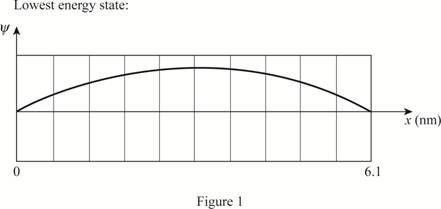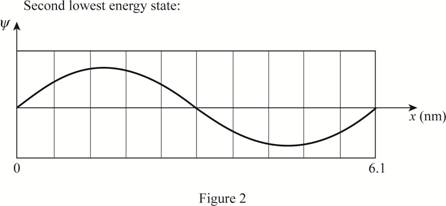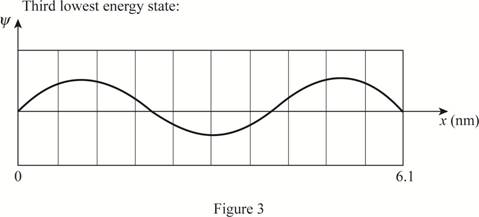
Concept explainers
(a)
The length of the one-dimensional box.
(a)
Answer to Problem 70P
The length of the box is
Explanation of Solution
The ground state energy of the electron in a box is
Write the expression for energy of the quantized level.
Here,
Write the expression for ground state energy for a particle in box.
Here,
Rearranging (I)
Substituting
Thus, the length of the box is
(b)
The plot of wave functions of the first three state.
(b)
Explanation of Solution
Write the expression for the wave function of a particle in a box.
Here,
Substitute
Here,
Here,
Here,
The plot of the wave functions versus position is given below:



(c)
The wavelength of the electron in the third state.
(c)
Answer to Problem 70P
The wave length of the electron in the second excited state is
Explanation of Solution
Substituting
Here,
Write the expression for de Broglie wavelength of an electron.
Here,
The particle in a box model renders only the kinetic energy since the potential is zero at the box and is infinite everywhere else. Thus, consider,
Substituting
Rearranging
Substituting
Thus, the wave length of the electron in the second excited state is
(d)
The wavelength of the emitted photon during the downward transition of the electron.
(d)
Answer to Problem 70P
The possible wavelengths of the emitted photons are
Explanation of Solution
The wavelength of the photon is
Write the expression for energy of a photon.
Here,
Write the expression for energy of the quantized levels in terms of the ground state energy
Subtracting
Here,
Rearranging (XII)
Substituting
Substitute
Thus when the electron absorbs the photon, it is excited to the third state.
The possible downward transitions are
Write the expression for energy of the photon during a downward transition.
Here,
Substituting
Substituting
Substituting
For,
Substituting
Substituting
For,
For,
Thus, the possible wavelengths of the emitted photons are
Want to see more full solutions like this?
Chapter 28 Solutions
Physics
- Rod AB is fixed to a smooth collar D, which slides freely along the vertical guide shown in (Figure 1). Point C is located just to the left of the concentrated load P = 70 lb. Suppose that w= 17 lb/ft. Follow the sign convention. Part A Figure 3 ft -1.5 ft √30° 1 of 1 Determine the normal force at point C. Express your answer in pounds to three significant figures. ΜΕ ΑΣΦ Η vec Nc= Submit Request Answer Part B Determine the shear force at point C. Express your answer in pounds to three significant figures. VC= ΜΕ ΑΣΦΗ vec Submit Request Answer Part C Determine the moment at point C. Express your answer in pound-feet to three significant figures. Mc= Ο ΑΣΦ Η vec Submit Request Answer Provide Feedback ? ? lb lb ? lb-ftarrow_forwardConsider a uniformly charged ring of radius R with total charge Q, centered at the origin inthe xy-plane. Find the electric field (as a vector) at a point on the z-axis at a distance z above thecenter of the ring. Assume the charge density is constant along the ring.arrow_forward3) If the slider block C is moving at 3m/s, determine the angular velocity of BC and the crank AB at the instant shown. (Use equation Vs Vc wx fuc, then use equation Vs VA + Ve/athen write it in terms of w and the appropriate r equate the two and solve) 0.5 m B 1 m 60° A 45° vc = 3 m/sarrow_forward
- 3) If the slider block C is moving at 3m/s, determine the angular velocity of BC and the crank AB at the instant shown. (Use equation Vs Vc wxf, then use equation V, VA + Va/Athen write it in terms of w and the appropriate r equate the two and solve) f-3marrow_forwardPls help ASAParrow_forwardPls help ASAParrow_forward
- 14. A boy is out walking his dog. From his house, he walks 30 m North, then 23 m East, then 120 cm South, then 95 m West, and finally 10 m East. Draw a diagram showing the path that the boy walked, his total displacement, and then determine the magnitude and direction of his total displacement.arrow_forwardPls help ASAParrow_forwardPls help ASAParrow_forward
- Pls help ASAParrow_forwardPls help ASAParrow_forward12. A motorboat traveling 6 m/s, West encounters a water current travelling 3.5 m/s, South. a) Draw a vector diagram showing the resultant velocity, then determine the resultant velocity of the motorboat. b) If the width of the river is 112 m wide, then how much time does it take for the boat to travel shore to shore? c) What distance downstream does the boat reach the opposite shore?arrow_forward
 College PhysicsPhysicsISBN:9781305952300Author:Raymond A. Serway, Chris VuillePublisher:Cengage Learning
College PhysicsPhysicsISBN:9781305952300Author:Raymond A. Serway, Chris VuillePublisher:Cengage Learning University Physics (14th Edition)PhysicsISBN:9780133969290Author:Hugh D. Young, Roger A. FreedmanPublisher:PEARSON
University Physics (14th Edition)PhysicsISBN:9780133969290Author:Hugh D. Young, Roger A. FreedmanPublisher:PEARSON Introduction To Quantum MechanicsPhysicsISBN:9781107189638Author:Griffiths, David J., Schroeter, Darrell F.Publisher:Cambridge University Press
Introduction To Quantum MechanicsPhysicsISBN:9781107189638Author:Griffiths, David J., Schroeter, Darrell F.Publisher:Cambridge University Press Physics for Scientists and EngineersPhysicsISBN:9781337553278Author:Raymond A. Serway, John W. JewettPublisher:Cengage Learning
Physics for Scientists and EngineersPhysicsISBN:9781337553278Author:Raymond A. Serway, John W. JewettPublisher:Cengage Learning Lecture- Tutorials for Introductory AstronomyPhysicsISBN:9780321820464Author:Edward E. Prather, Tim P. Slater, Jeff P. Adams, Gina BrissendenPublisher:Addison-Wesley
Lecture- Tutorials for Introductory AstronomyPhysicsISBN:9780321820464Author:Edward E. Prather, Tim P. Slater, Jeff P. Adams, Gina BrissendenPublisher:Addison-Wesley College Physics: A Strategic Approach (4th Editio...PhysicsISBN:9780134609034Author:Randall D. Knight (Professor Emeritus), Brian Jones, Stuart FieldPublisher:PEARSON
College Physics: A Strategic Approach (4th Editio...PhysicsISBN:9780134609034Author:Randall D. Knight (Professor Emeritus), Brian Jones, Stuart FieldPublisher:PEARSON





